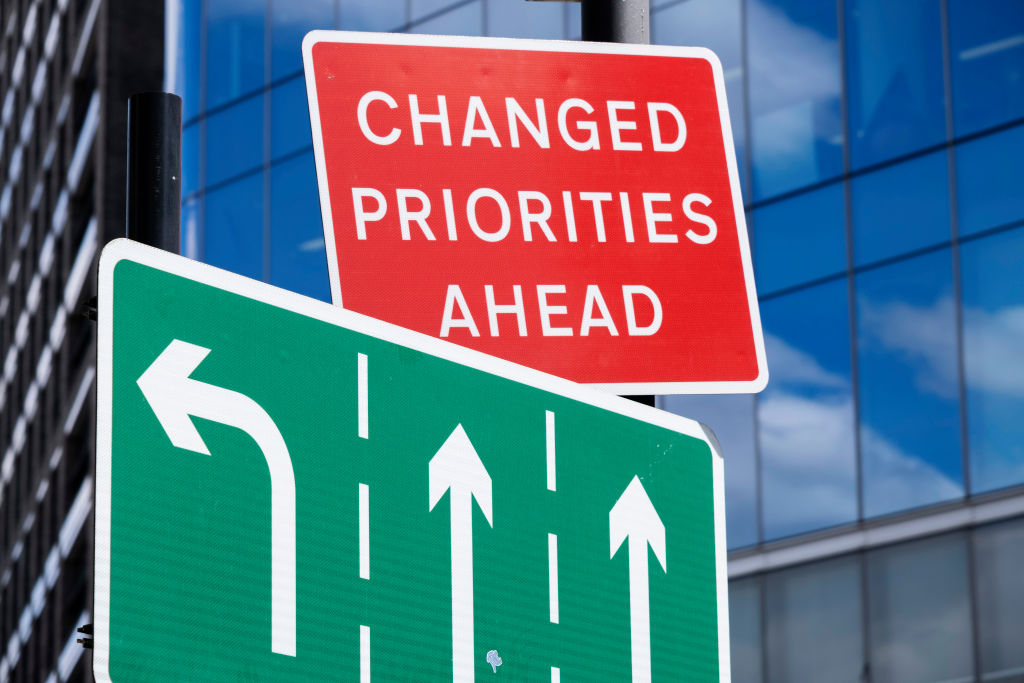A nation’s vision is more than the sum total of its citizens’ desires.
Two Cheers for Milton Friedman

Under radically new conditions, some of the old insights need modifying.
This essay was originally delivered as a speech for the William F. Buckley, Jr. Program’s twelfth annual conference, commemorating the 60th anniversary of Milton Friedman’s Capitalism and Freedom.
Recently I had occasion to re-read Milton Friedman’s Capitalism and Freedom. I expected to find there the same extraordinary case for human freedom I remembered from my first encounter with this book a decade ago as a university student.
Instead, while those declarations of freedom were still in there, I found myself troubled as to the extent of their relevance and application to the challenges that confront us, and the country we love, in the 21st century.
For example, Friedman writes about the shortcomings of collective political decision-making. He thought the democratic process suffered by comparison to the free and individualist market, in which every man can choose for himself and himself only among nearly endless options. The political, in Capitalism and Freedom, is an imperfect solution of last resort, to be avoided if a market solution is feasible. But consider that today, the political may be our only defense against exactly the type of private tyranny whose existence, this book insists, is impossible.
Consider further a couple of specific examples from Capitalism and Freedom: the BBC could only refuse Winston Churchill access to the ears of the British public because it was state-owned, and the state before WWII considered Churchill’s warnings about Hitler’s rise unacceptably incendiary. True enough, so far as it goes.
But today the coordinated actions of nearly all major tech companies can collude to strip from the digital public square all ideas contrary to the narrative in which they share belief. Even hearings held by our elected officials, if they contain unacceptable crimethink, have been removed from YouTube and subsequently are unable to be shared across various platforms.
It seems that the private market can indeed accomplish anything the government can, at least as effectively—including censorship.
Friedman also writes that the profit motive will protect us from such censorship, because, in his words, “the publisher cannot afford to publish only books with which he agrees.” But the publisher (or distributor) very much can do so, as we’ve seen with books like those of Ryan Anderson and Abigail Shrier on the subject of transgenderism, banned from Amazon and Target along with other retailers. This is especially the case if the publisher can count on his major competitors, who overwhelmingly went to the same schools and subscribe to largely the same ideas about what is unacceptable, to do the same.
In fact, as that imperfect political sphere has receded, the resulting vacuum has not been filled by a purely free market so much as a managerial and bureaucratic class and economy, both, and sometimes jointly, public and private. James Burnham, not Friedman, proved the more prophetic about the world we now live in.
Slaying Woke Monsters
But of course, even with these critiques there is much to recommend Capitalism and Freedom in our age too. That Friedman focused on defending us from collectivist central planning in an era when it was powerfully on the march does not, of course, mean that his work or the many excellent proposals therein should be jettisoned in a fit of—to paraphrase the late, great Justice Scalia—the “smug assurances” of our particular age.
It is to Friedman’s great credit that many of his ideas and solutions might find new life and importance in new circumstances. One such great idea is school choice, then imagined as vouchers, now updated as fully flexible education savings accounts. This transition originated with Friedman himself in a 2003 interview with EdNext, in which he championed what he called “partial vouchers.” Unlike a set-amount voucher, ESAs can be used to assemble a custom education from multiple providers. Unused funds can also be rolled over year-to-year, eventually into a college or post-high school vocational training fund. This moves ESAs closer to Friedman’s most-preferred category of spending in Free to Choose, spending one’s own money on oneself. It provides an incentive to shop and compare for price-performance.
Friedman’s arguments in favor of school choice rest on what might be described as libertarian grounds—increased competition results in improved quality—as well as left-liberal ones—choice provides the most benefit for those least-well served by our assigned government schooling, including low-income and minority students.
But there is also an explicitly conservative case to be made for Milton’s grand idea.
As has become abundantly clear in recent years, the leftist indoctrination that William F. Buckley, Jr. observed at Yale 70 years ago has consumed not only the academy, but consequently spread out from it into all of our important institutions, including the K-12 system.
On the backdrop of this reality, school choice provides two enormous potential benefits for those who hope to conserve even a glimmer of what was once considered the American way of life.
First, it provides not just an escape hatch but, even more importantly, leverage to the parents currently swarming school board meetings to object to critical race theory, gender ideology, and other objectionable content in their children’s classrooms. Imagine the difference in power dynamics in these confrontations if each angry parent represented the potential loss of $14,500 a year, the average expenditure in public schools (before the additional flood of federal money during COVID). Parents would likely receive a very different reception than the range from indifference to outright hostility they have faced under present circumstances if their dissatisfaction was tied directly to teacher and administrator salaries.
The consumer power Friedman championed can also be harnessed as a powerful tool in the culture war.
To paraphrase Friedman himself, “if parents can choose, then administrators”—now enthralled to their new woke religion—“cannot dictate.”
Second, universal school choice would allow the Right—or even just the sane—to claim our rightful share of the enormous public investment in secondary education, now a staggering $800 billion per year (again, excluding COVID funds). Not only will less of that money be directly funding the ideas of our opponents, it would be positively invested in institutions that would not be inherently hostile to us, our values, and our children, providing a critical jump start to the most important project now before the Right, which is to build alternative institutions to those hopelessly captured by the radical Left.
These cultural arguments have been the cause—along with the potent accelerant of pandemic school closures—of what, simply put, has been the most successful year for school choice in two decades. In the 2021 legislative sessions, 18 states expanded or created school choice programs. West Virginia went from having no school choice options whatsoever, even charter schools, to passing both a charter law and a universal ESA program, becoming the first state in the country to implement such a law.
In addition to K-12 education, Friedman’s ideas and policy proposals retain much relevance in many of the sectors most pressing to the financially beleaguered middle class. Oren Cass of American Compass has noted that the three most devastating financial pressures on working- and middle-class households currently are those of housing, healthcare, and higher education.
All three could use a heavy dose of Milton, and I’ll leave the first two to others more expert in those areas of policy. But in the case of the third, the evidence is even more overwhelming than it was 60 years ago. Far from opening opportunities to lower-income students as intended, government programs like grants, subsidies, and student loans to universities have made them ever more insulated bastions of elitism and leftism.
After more than 50 years of enormous subsidies and student loans designed to help low-income students, students from families in the lower half of the income spectrum make up a smaller percentage of those on campus than they did 50 years ago when those Great Society programs were enacted. Universities, on the other hand, have used those benefits to become extremely rich and powerful as conduits to the elite. It’s clearer than ever that the woke monster is fed heavily by higher education with its heavy taxpayer subsidies.
More Is Needed
In looking around us today, it seems that the proper role of government in a free society must, at some base level, include the role of cultivating the sorts of citizens who can perpetuate that free society. That might be a vision of government too energetic to fit comfortably into the vision described in Capitalism and Freedom.
But while the free market is undoubtedly the best economic system for producing prosperity—and is responsible for granting those of us here in this country a level of it unheard of in the history of mankind—it is not a panacea, and we should not restrain ourselves arbitrarily from searching outside its boundaries for solutions to the particular challenges of our age.
In 1972, Milton Friedman invited Irving Kristol to deliver a lecture at the Mont Pelerin Society, which Friedman headed at the time. That Kristol was invited to give the speech I will cite in a moment suggests that Friedman himself found arguments along these lines a compelling and troubling challenge to his own ideas, at least to some degree.
Among Kristol’s remarks was this:
One of the most extraordinary features of our civilization today is the way in which the “counterculture” of the New Left is being received and sanctioned…. Our capitalists embrace the ethos of the “New Left” for only one reason: they cannot think of any reason why they should not….
[Friedman] assumes, as I read him, that one must not interfere with the dynamics of self-realization in a free society. He further assumes that these dynamics cannot, in the nature of things, be self-destructive—that “self-realization” in a free society can only lead to the creation of a self compatible with such a society.
[But] what if the “self” that is realized under the conditions of liberal capitalism is a self that despises liberal capitalism, and uses its liberty to subvert and abolish a free society?
To this question, Hayek and Friedman have no answer. And yet this is the question we now confront, as our society relentlessly breeds more and more such selves….
Perhaps one can say that the secular, libertarian tradition of capitalism…simply has too limited an imagination when it comes to vice. It could never really believe that vice, unconstrained by religion, morality, and law, might lead to viciousness. It never really could believe that self-destructive nihilism was an authentic and permanent possibility that any society had to guard against. It could refute Marx effectively, but it never thought it would be called on to refute the Marquis de Sade or Nietzsche.
Friedman’s championed free market can produce and sell us whatever we desire better than any system yet devised. But as with any economic system, it cannot tell us if what we desire is good or compatible with the continuation of the very free society that sustains it.
It may be that the “self” Kristol so presciently described, so fully realized in an abundant capitalist economy, and absent additional, normative commitments the free market itself can never provide, is incapable of sustaining a free society.
Without such “pre-modern” concerns as a conception of the common good and commitment to non-neutral, normative values about what constitutes the good life, the free market alone cannot muster any defense against the self-destructive and nihilistic impulses that threaten, not just the capitalist system, but the entirety of the American project.
I have too much respect for Milton Friedman to imagine him a dogmatist. Indeed, in successive editions of Capitalism and Freedom he admirably faces up to some of the challenges to his worldview posed by China and its blend of economic liberalization alongside political tyranny. Perhaps if we were lucky enough to still have him with us and get another edition of this book, he would have good responses to some of its seeming shortcomings in addressing the challenges that face us now.
Many of the ideas in Kristol’s 1972 speech found their way into a later article titled “Two Cheers for Capitalism.”
So let me offer two cheers—but not three—for Milton Friedman’s classic, Capitalism and Freedom.
Correction: An earlier version of this article stated that Irving Kristol delivered his Mont Pelerin Society speech in 1973. The speech was published in 1973 but delivered in 1972.
The American Mind presents a range of perspectives. Views are writers’ own and do not necessarily represent those of The Claremont Institute.
The American Mind is a publication of the Claremont Institute, a non-profit 501(c)(3) organization, dedicated to restoring the principles of the American Founding to their rightful, preeminent authority in our national life. Interested in supporting our work? Gifts to the Claremont Institute are tax-deductible.
Without a revival of purpose and moral clarity, neither the free market nor the government will save America.
Classical liberalism’s future depends on reinvigorating the moral foundations for its core ideas.



